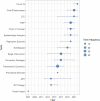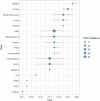Modelling HIV/AIDS epidemiological complexity: A scoping review of Agent-Based Models and their application
- PMID: 38306355
- PMCID: PMC10836677
- DOI: 10.1371/journal.pone.0297247
Modelling HIV/AIDS epidemiological complexity: A scoping review of Agent-Based Models and their application
Abstract
Objective: To end the AIDS epidemic by 2030, despite the increasing poverty and inequalities, policies should be designed to deal with population heterogeneity and environmental changes. Bottom-up designs, such as the Agent-Based Model (ABM), can model these features, dealing with such complexity. HIV/AIDS has a complex dynamic of structural factors, risk behaviors, biomedical characteristics and interventions. All embedded in unequal, stigmatized and heterogeneous social structure. To understand how ABMs can model this complexity, we performed a scoping review of HIV applications, highlighting their potentialities.
Methods: We searched on PubMed, Web of Science, and Scopus repositories following the PRISMA extension for scoping reviews. Our inclusion criteria were HIV/AIDS studies with an ABM application. We identified the main articles using a local co-citation analysis and categorized the overall literature aims, (sub)populations, regions, and if the papers declared the use of ODD protocol and limitations.
Results: We found 154 articles. We identified eleven main papers, and discussed them using the overall category results. Most studies model Transmission Dynamics (37/154), about Men who have sex with Men (MSM) (41/154), or individuals living in the US or South Africa (84/154). Recent studies applied ABM to model PrEP interventions (17/154) and Racial Disparities (12/154). Only six papers declared the use of ODD Protocol (6/154), and 34/154 didn't mention the study limitations.
Conclusions: While ABM is among the most sophisticated techniques available to model HIV/AIDS complexity. Their applications are still restricted to some realities. However, researchers are challenged to think about social structure due model characteristics, the inclusion of these features is still restricted to case-specific. Data and computational power availability can enhance this feature providing insightful results.
Copyright: © 2024 Anderle et al. This is an open access article distributed under the terms of the Creative Commons Attribution License, which permits unrestricted use, distribution, and reproduction in any medium, provided the original author and source are credited.
Conflict of interest statement
The authors have declared that no competing interests exist.
Figures




References
-
- UNAIDS U. UNAIDS terminology guidelines. 2011.
-
- Social Determinants of Health—MeSH—NCBI. [cited 12 Jan 2022]. Available: https://www.ncbi.nlm.nih.gov/mesh/?term=social+determinants+of+health
-
- Dangerous inequalities: World AIDS Day report 2022. 2022.
-
- Fast-Track—Ending the AIDS epidemic by 2030. [cited 12 Jan 2022]. Available: https://www.unaids.org/en/resources/documents/2014/JC2686_WAD2014report
Publication types
MeSH terms
Grants and funding
LinkOut - more resources
Full Text Sources
Medical
Miscellaneous

